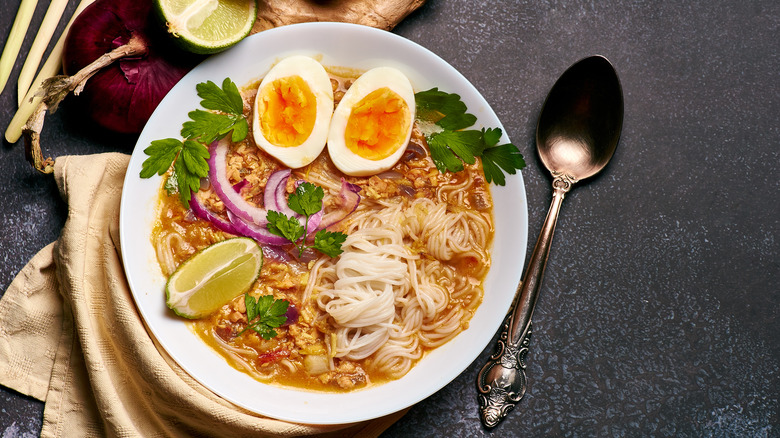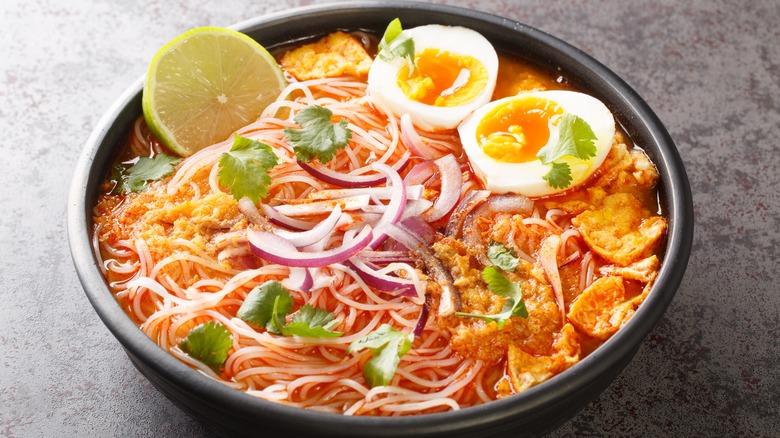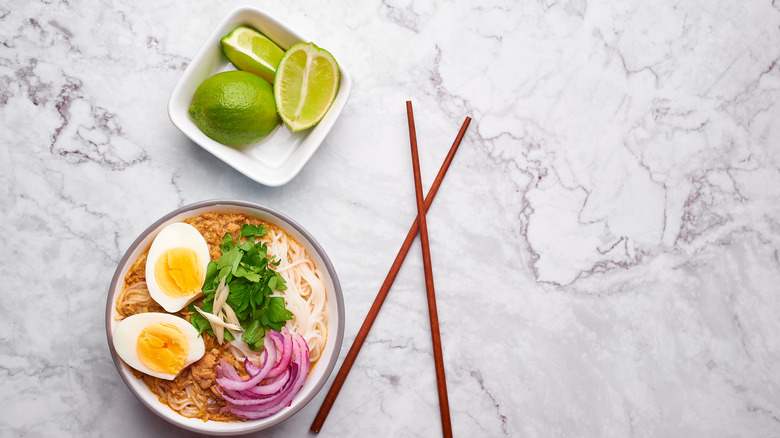Myanmar's Mohinga Is A Cozy Fish Soup Perfect For A Hearty Breakfast
Although pancakes, cereal, and eggs may be the go-to breakfast in the U.S., several Asian cuisines reach for soup instead. Whether it's pho in Vietnam or thin, savory porridge Khao tom in Thailand, there's an undeniable appeal to a liquidy and spicy start to the day.
In Myanmar, the most common breakfast is soup, too — a dish known as mohinga. Made using a catfish base, the food has a complex taste, featuring sweet, sour, salty, and spicy elements. The preparation derives from an extensive array of aromatics like root vegetables, peppers, and spices, bound together with rice flour. Served at street food stalls across the country, it's often topped with eggs and fritters for a satiating start to the day.
One quality is dependable — there's a spicy note to finish — but otherwise, chefs craft regional renditions, reflecting generational techniques and local ingredients. Over the years, mohinga's become one of Myanmar's most infamous culinary creations. Let's dive into the background.
A longstanding comfort food staple
The aromatic mohinga is one of Myanmmar's most popular foods, with consumption spanning centuries. The first reference in print dates back to a poem from the Alaungpaya Dynasty. This final kingdom of Myanmar lasted for 133 years up to British control in 1885. However, it's likely the food was already commonly enjoyed as a staple for the working class before then, with some citing origins all the way back to the first century. Especially in the last few hundred years, the dish has endured through shifting political climates. It remained a staple both under British imperial rule and after military leadership during the 20th century. Today, it continues to be a popular street food, with its price often utilized as an economic indicator.
Mohinga is enjoyed all around Myanmar, with varying regional differentiations. In coastal areas — such as the Rakhine province — the dish involves more seafood and is called Mont Di. While in the northern Shan state, the broth is built upon a fermented bean paste called pèhbal. There are also further differentiations between rural and urban renditions. The soup shifts in constituents, thereby encompassing Myanmar's cultural and ecological diversity.
How Mohinga is made
While mohinga shifts in ingredients and preparation techniques, there is a general procedure of preparation. The dish starts with the toasting of flour made from pulverized rice granules, along with the occasional inclusion of chickpea flour. Next, a spice paste for the broth is prepared in a mortar and pestle, involving a variable medley of ginger, garlic, onion, chilies, and lemongrass. Some toss the aromatics into simmering water alongside salt and white pepper to build a broth. Others first sautee the vegetables, also incorporating turmeric and chili powder. Fish, traditionally catfish, is introduced to the pot and melded with components alongside shrimp paste and fish sauce. Water is topped up, building the broth. Either immediately or after simmering, the flour is added to thicken the soup. The soup cooks anywhere from fifteen minutes to an hour.
At the same time, rice vermicelli noodles are boiled separately. They're then divided into varying bowls, into which the broth is poured. Frequent garnishes include lime, chili oil, boiled eggs, cilantro, varying fried fritters, and additional fish sauce to taste.


